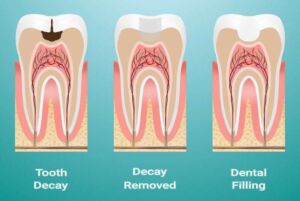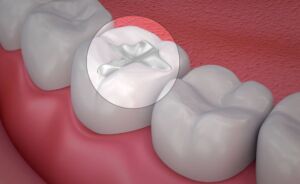{:en}Filling helps to restore the normal function and shape of a tooth damaged by caries, as well as to prevent further development of caries by eliminating the areas through which bacteria can penetrate into the deeper tissues of the tooth.
Filling Procedure
To minimize pain during the filling and make your visit as pleasurable as possible, Dr Bennett may decide to administer a local anesthetic, such as lidocaine. Then he uses a bur or laser to use the caries-affected tissue.
After the caries has been removed, the dentist creates a space for the filling. Depending on the type of filling material, it is necessary to perform different procedures for the formation of the site to securely secure the filling. The dentist may place a ba se or cushioning material inside the tooth to protect the tooth pulp (the part where the nerves and blood vessels are located).
se or cushioning material inside the tooth to protect the tooth pulp (the part where the nerves and blood vessels are located).
Certain types of filling material are hardened when treated with special light. When using these fillings, the dentist applies the material in layers, pausing to illuminate the resin with ultraviolet light. This causes curing of the material and gives it strength. At the final stage, after placing the filling, the dentist processes and polishes the tooth surface using a bur and special attachments.
After the filling procedure, when the local anesthetic wears off, a number of adverse reactions can be observed. The tooth can react to pressure, cold air or liquid, or to sweets. Some people experience numbness, tingling, and mild pain around the injection site. These side effects often resolve within a few hours after the procedure. It is recommended to avoid eating until the anesthetic wears off.
The hypersensitivity should resolve within one to two weeks. Until this moment, it is necessary to avoid factors that provoke its development. If the tooth remains hypersensitive, or if the sensitivity does not decrease after two weeks, you should see your dentist.
The most common cause of pain after filling is that the layer of filling material is too high, and therefore the dentist must correct the position of the filling by checking the occlusion (closing) of the teeth and removing excess filling material to reduce pain. Sometimes hypersensitivity does not go away even after adjusting, which can mean that the decay has affected the nerve and the tooth couldn’t be saved with a filling. In this case a root canal procedure is recommended.
Affordable dental fillings in Coral Springs are available. Same day appointments, simply dial (786) 440-4948.
We offer all dental procedures under the same roof. We install same day implants and preform same day root canal procedures to ease your pain and be convenient for you.{:}{:es}El relleno ayuda a restaurar la función normal y la forma de un diente dañado por caries, así como a prevenir un mayor desarrollo de caries al eliminar las áreas a través de las cuales las bacterias pueden penetrar en los tejidos más profundos del diente.
Procedimiento de llenado
Para minimizar el dolor durante el relleno, el dentista puede decidir administrar un anestésico local, como la lidocaína. Luego, el dentista usa una fresa o un láser para usar el tejido afectado por la caries.

Una vez que se ha eliminado la caries, el dentista crea un espacio para el relleno. Dependiendo del tipo de material de relleno, es necesario realizar diferentes procedimientos para la formación del sitio para asegurar de forma segura el relleno. El dentista puede colocar una base o material de protección dentro del diente para proteger la pulpa del diente (la parte donde se encuentran los nervios y los vasos sanguíneos).
Ciertos tipos de material de relleno se endurecen cuando se tratan con una luz especial. Al usar estos empastes, el dentista aplica el material en capas, deteniéndose para iluminar la resina con luz ultravioleta. Esto provoca la polimerización (curado) del material y le da resistencia. En la etapa final, después de colocar el relleno, el dentista procesa y pule la superficie del diente usando una fresa y accesorios especiales.
Después del procedimiento de llenado, cuando desaparece el efecto de la anestesia local, se pueden observar una serie de reacciones adversas. El diente puede reaccionar a la presión, al aire frío o al líquido, o a los dulces. Algunas personas experimentan entumecimiento, hormigueo y dolor leve alrededor del lugar de la inyección. Estos efectos secundarios a menudo se resuelven pocas horas después del procedimiento.
La hipersensibilidad debería desaparecer en una o dos semanas. Hasta este momento, es necesario evitar factores que provoquen su desarrollo. Si el diente permanece hipersensible, o si la sensibilidad no disminuye después de dos semanas, debe consultar a su dentista.
La causa más común de dolor después del relleno es que la capa de material de relleno es demasiado alta y, por lo tanto, el dentista debe corregir la posición del relleno comprobando la oclusión (cierre) de los dientes y eliminando el exceso de material de relleno para reducir el dolor.{:}










